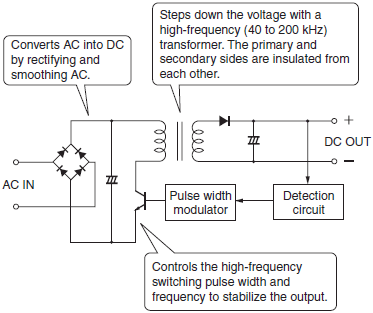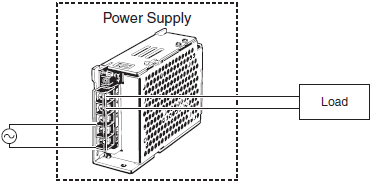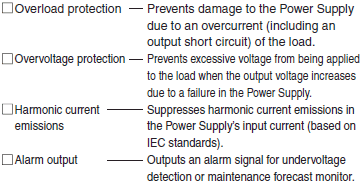Power Supplies
OMRON provides many types of general-purpose Power Supplies, such as the type mounted to DIN rail or the type built into equipment. OMRON also provides the S8VS which provides notification of replacement timing, and the Buffer Block that handles momentary power interruptions, and other highly reliable Power Supplies.
| Introduction | Features |
| Principles |
|
| Engineering Data |
|
|
|
|
What Is a Power Supply?
To obtain electricity, we use commercial AC power that is sent from power plants. But the integrated circuits and electronic components used inside office automation equipment, factory automation equipment, and other electronics cannot be operated with the AC voltage, and they will be damaged by the high voltages.
Stable DC voltages are required to operate these integrated circuits and electronic components.
The device that converts commercial AC power to regulated DC power is called a regulated DC Power Supply.
There are two main methods for controlling regulated DC Power Supplies.
Switch-mode Power Supplies and Linear Power Supplies are regulated DC Power Supplies, which are generally referred to as Power Supplies. Currently, Switch-mode Power Supplies are the most common because they are compact, lightweight, and highly efficient.
Configuration and Principles
Switch-mode Power Supplies
Switch-mode Power Supplies take commercial AC power as the input and convert it to high-frequency power using the high-speed switching of semiconductors to obtain the required direct current. Switch-mode Power Supplies are used for most electronic devices as Power Supplies because they are compact, lightweight, and highly efficient.

Disadvantages
Noise is generated due to high-frequency switching.
Large inrush current on the primary side.
Selection Methods
Select a model of Power Supply according to your application.

Each Power Supply has an input voltage range. Select the Power Supply according to the available input voltage.
Output Capacity
Output capacity (W) = Output voltage (V) × Load current (I)
Select the Power Supply so that the maximum load capacity will be lower than the rated output capacity.
Note:The output of the Power Supply may not rise or may rise slowly due to the ambient temperature and the startup current and inrush current of the load connected to the Power Supply, even when the load is within the Power Supply capacity during normal operation.
There is a risk of damage to the Power Supply from internal heat generation and a reduction in the life expectancy if the Power Supply is used when the load current exceeds the rated current.
Operating Methods
Consider the operating methods to increase output capacity, voltage, and reliability. (Not all models of Power Supply support all of the operating methods.)

Note:Refer to the Power Supply datasheets because external components or consideration of derating may be required depending on the operating method.
Additional Functions
Check the required functions.
(The availability of additional functions depends on the model.)

Note:Alarm output terminals are available as open-collector outputs and relay outputs with voltage and current specifications. Refer to the Power Supply datasheets.
Protection Functions
All models are equipped with overvoltage protection and overload protection.
Note:The startup characteristics of the load are affected depends on the overload protection characteristics.
Shape and Mounting Method
Power Supplies of various shapes are available. Select the most suitable Power Supply according to the application.
Various mounting brackets are also available.
Installation
The mounting direction and space requirements are specified for each model. Make sure that the Power Supply has sufficient space for airflow.
Note:The load rate may have to be reduced depending on the mounting directions.
The warranty period and life expectancy of the Power Supply depend on the model. Select a model with suitable specifications for your application.
Warranty Period:
This is the period during which the Power Supply will be exchanged or repaired at no charge if it fails when used under the specified usage conditions during the warranty period.
Life Expectancy:
This is the period during which the Power Supply will satisfy performances under conditions similar to those of actual usage. The Life Expectancy is not a guaranteed value. It has been calculated from temperature rise tests of the aluminum electrolytic capacitor when the Power Supply is used with the standard mounting and the rated input voltage, an ambient temperature of 40°C, and a load rate of 50%.
Note:Periodic maintenance is required for the cooling fan.
Safety Standards
Models are available that comply with either UL, CSA, and VDE standards or EN standards.
Refer to the Power Supply datasheets for certification and conforming standards.


